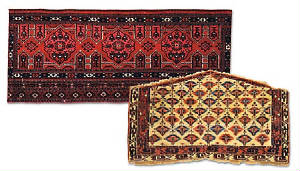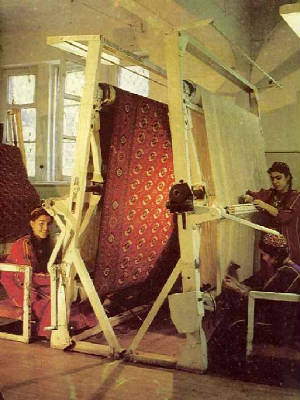 History of Turkmen Rugs
Serious research into the weaving culture of the Turkmen's must, of course, encompass
more than aesthetic appreciation. The beauty of such weavings has unquestionably been the most important factor both for historians
and collectors but it is the starting point, the motivation for a greater curiosity. The history, genealogy, beliefs and way
of life of the Turkmen steppe peoples are all of great importance to their art. Turkmen rugs, therefore, with their distinctive
palettes, motifs and compositions, are not merely examples of a strange and exotic 'folk' art but represent a highly complex
and historically continuous culture. This strong historical continuity was made possible by the innate conservatism of Western
and Central Asian tribal cultures and, most importantly, by their nomadic, or semi-nomadic, way of life. The Turkmen's (who
belong to a Western Turkic language group - unlike any other Central Asian peoples) have thus been able to maintain and develop
their own special culture.
Because the majority were nomads or semi-nomads, hardly any written sources exist to indicate
the origins of the Turkmen's hut it is clear that they are descended from the Oghuz tribe, whose genealogies list a few names
still found in the 19th century. Other descendants of the Oghuz were the Seljuk's and Ottomans, who built great empires from
the 11th century onwards, their power and territorial expansion creating a Turkic-based culture into eastern Europe, North
Africa and Spain. Within this historical context, Therefore, it is not difficult to see the importance of the Oghuz and their
descendants; and the history of the Oghuz. With all its later political and geographical ramifications, is crucial to a proper
understanding of Turkmen weaving, as will become clear.
 Way of Life
The earliest researchers into the Turkmen's and their weaving culture started from the assumption that the Turkmen had
always been nomads and therefore the historical roots of their weaving were to he found in nomadic traditions. That the art
of knotting grew out of the practical necessities of a nomadic way of life appears to he a convincing hypothesis. Mobility
was an important requirement of this lifestyle and all the nomad's personal property had to he, as far as possible. Light,
easily transportable and made from readily available raw materials, the most important of which was the wool from their own
flocks of sheep. Piled carpets provided protection from the cold underfoot - in these climates, freezing temperatures seep
up from the ground at night - and could also he used as covers and blankets.
However, the general opinion today is that
although nomads unquestionably played an important part in the development of pile weaving, they may not actually have invented
it. In the nomadic environment, it was easier to make felts and fiat-weaves. Felting, indeed, is probably among the oldest
of textile techniques. No loom is needed and items can he made in a comparatively short time. By contrast, the production
of a knotted carpet can take several months, and thus it is hardly a technique suitable for a nomadic way of life. Whenever
carpets are depicted in early art, whether Eastern or Western, they are associated with power and wealth, both religious and
secular. From such evidence, it would seem that for a long time pile weavings were the preserve of the upper echelons of the
societies, which made or imported them. It is therefore more likely that they were produced by settled communities rather
than by semi-nomadic ones. The manufacture of rugs by knotting woolen threads on to a net-like ground structure was probably
derived from flat-weave techniques. The development from a continuous flat-weave such as sumak, through such loose pileping
as the loop-pile technique to the final refinement of 'knotting' seems logical. It was not only geography and climate, which
forced many of the inhabitants of Central Asia into a nomadic way of life. There was also the constant plundering and pillaging
which went on between neighboring groups, the fight for good grazing lands at different times of the year, the struggle to
secure access to water supplies and the constant internecine battles between the Turkmen's themselves. The origins and development
of equestrianism among the steppe nomads, starting with the Scythians around 700 B.C., are also of considerable importance
when discussing the history of this region.
The Turkmen's were divided into tribes, the number of which it is now hard
to estimate; the tribes themselves were further sub-divided into various kinship groups and individual families, much like
the large tribal confederations in Iran, many of which are also wholly or in part of Turkic origin. The Turkmen family lived
in a distinctive tent, called a yurt, which could be erected and dismantled within a few hours. The base of a yurt was a lattice-like
construction made of willow with a domed roof and covered in felt.
Horses were the key to a tribe's power, and served as
their major status symbol. The principal source of its wealth was its sheep which provided wool, milk and, on festive occasions,
meat. The task of hooking after the flocks, as well as weaving, fell to women. Other raw materials for weaving, although to
a much lesser extent, were obtained from camels and goats.
|
 |
|
|
 |
|
|
 |
|
|
|

